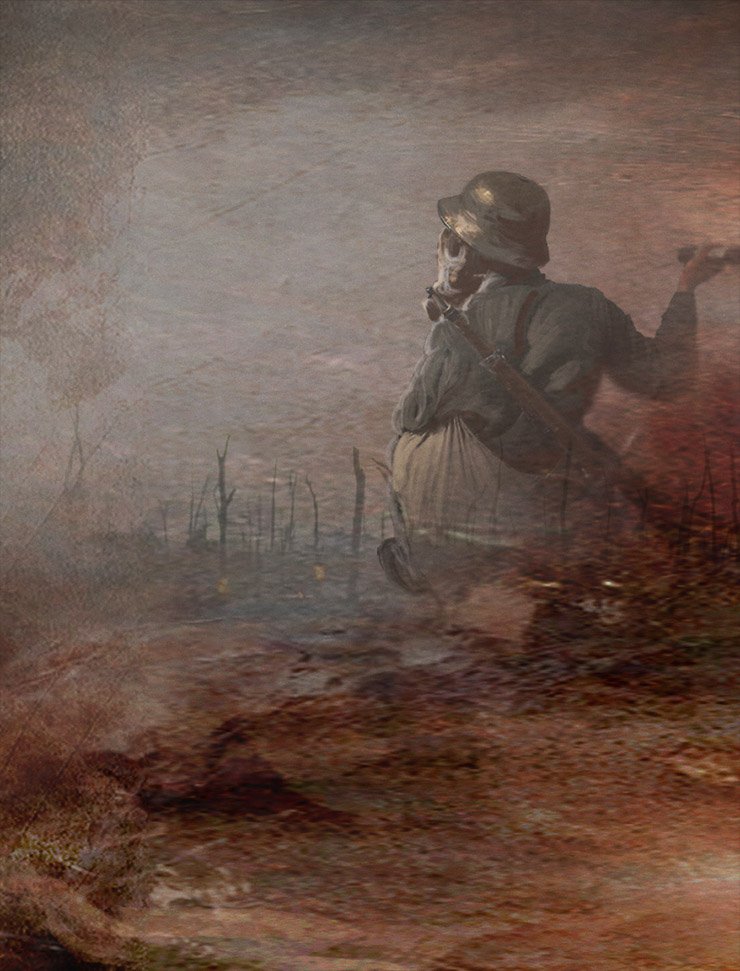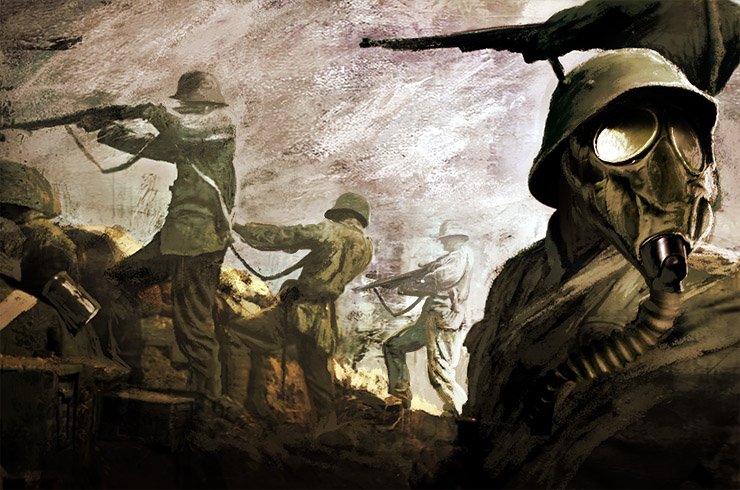Stormtroopers
When Quartermaster General Erich Ludendorff took over German High Command in 1916, he knew that he needed to change things if the First World War was to be won.
The traditional mass tactics were a thing of the past and had only produced huge casualties for little gain. To break the stalemate of trench warfare, he and his command explored the qualities of individual soldiery.
By 1916, the idea of the Sturmtruppen had begun to take root within the German Army. “The Year of Battles”, as it would be known, at Verdun, the Somme and in Galicia, had again demonstrated the futility of throwing waves of men against entrenched defences. The “Stormtroop” concept offered something new: a cadre of highly trained, motivated and specialised assault units. The original “Sturmtrupps” were brought to life in the mountainous battlefields of the Vosges, the Carpathians and the Argonnes. Here, the terrain did not allow for continuous lines of trenches, and the defenders had to build a series of separated strong points instead. Fighting in the confined spaces of narrow mountain paths favoured aggressive shock troop tactics, and the first Stormtroopers were great at circumventing enemy positions and infiltrating their perimeter before attacking from the flanks and rear. Outfits like the original Sturmabteilung Rohr were also developed from the playbooks of trench raiders and combat patrols. Applying a deadly mix of shock, surprise and ultra violence, they would burst onto the scene and cause havoc among the defenders. But unlike regular infantry, the Sturmtruppen would not stop there, but would keep on pushing through the trenches to create maximum chaos and destruction.
The emerging “Stormtroopers” attracted a certain kind of soldier. Usually younger men, often under 25, unmarried and with a certain flair for recklessness and a disdain for death and danger. But there were also the older, more experienced veterans, professional soldiers and cold calculating killers. Physically, fitness was important for the job, as the demands on the body were high. But considered most important was their character. Each had to possess a certain ruthless and daredevil attitude. A single-minded determination was necessary to see advances carried out through total carnage and destruction, for in close-quarter combat there is no room for humanity. They would fight with daggers, clubs, entrenching tools and pistols, looking the enemy in the eye while punching, wrestling and killing. This was a job for a certain type of man, with unrelenting determination and iron in the soul, as Ernst Jünger’s writings would describe.
The weapons
The single strongest motivation was the “Stoss”, the push and shock needed to break into enemy lines. Unlike trench raiders, Stormtroops were not there to capture prisoners or gather intelligence. Their sole objective was to clear a path and remove any obstacles in the way, living or otherwise. The constant danger and pressure formed a very tight bond between the men. They trained and lived together day by day and had to fully trust in each other’s abilities. Each was a specialist in his own right. Many came from the German Jägers and the newly introduced mountain units; they were expert marksmen and recon specialists. Others had been pioneers, and their technical expertise in handling explosives and flamethrowers brought tactical versatility to the mix. There were also machine gun specialists, trench mortar and grenade launcher units, so for whatever task lay ahead, the Stosstrupp could be mixed and matched appropriately. Each man was, of course, well trained in close combat and trench warfare, as well as with a wide arsenal of both native and foreign weapons and equipment.

They were armed with lighter carbines and machine guns like the MG08/15, but the weapon of choice for the Stosstrupp was the hand grenade. Going into action, they would carry sandbags full of stick and egg grenades with them – the first for concussion, the second for fragmentation. Emphasis was on accuracy and quickness of release. Each trooper would carry at least 5 or 6 grenades into battle, often in bags slung around the neck and shoulders. They were great tools to dislodge the enemy from fortified positions by bombarding loopholes and entrances.
Many weapons were specially modified for stormtrooper use. The P98 Luger was perfect for close combat in general, but its small magazine was quickly depleted. The stormtrooper Luger, though, was outfitted with a 32 round drum magazine, a longer barrel and a shoulder stock. It was basically a semi-automatic carbine by that point. Even more effective was the MP18 submachine pistol. Firing 400 rounds a minute, it was the perfect trench clearer. A new uniform was also designed to suit the especially rugged service of the stormtroopers. These were outfitted with mountain boots and trousers with leather patches on the buttocks and knees.
Over the years, the Germans would develop their Stormtrooper doctrines and ideas, but it was experimental by nature. Equipment and weapons were constantly exchanged and re-balanced in order to figure out what worked and what didn’t, but fighting on so many fronts simultaneously allowed the Germans to accumulate a large pool of knowledge and experience from their own forces as well as from their enemies. The French, British and Russians all deployed their own type of shock troops and death companies that were especially fierce in battle. Each mission, the Germans would study how the enemy had reacted to their attacks. What was his modus operandi? How would he direct his reserves and what weapons would he use?
German high command allowed its Stormtroop soldiers and commanders a great deal of freedom of decision in the field. If opportunities needed to be seized and momentum maintained, then there was no room for waiting or second guessing. Stormtroop tactics demanded decentralised leadership and low-level command structures. Instead of setting a rigid and restricted set of objectives, the men were given a broad goal and allowed to find their own way as to how to achieve it. NCOs (non-commissioned officers) were not only allowed but encouraged to lead through direct command and personal judgment, a concept which would later develop into the famed Auftragstaktik (mission tactics). Here, success depended on the determination and recklessness of the pack. Personal initiative, the dash and drive of the individual; these were to decide victory or death.
Instilling fear
The Stormtrooper soon had a certain image and a mythos, and both German soldiers and their allies and enemies began to take notice. For the Allies, the Stormtroopers became a sort of boogeyman. Sentries were paranoid about the idea of groups of Germans with trench-clubs stalking the night. The men themselves certainly knew that they were elite. They got the best training, the best equipment, and more weapons than any other outfit. They did not have to concern themselves with the woes of regular infantrymen. They were not there to hold the line or to prepare defences. They were there to break in, to destroy the enemy and open up a path. After each mission, if they got back alive, they were rotated out of the lines and trained for their next assignments.
A German Medical Officer recounts:
“The men of the storm battalions were treated like football stars. They lived in comfortable quarters, they travelled to the “playing ground” in busses, they did their jobs and disappeared again, and left the poor foot sloggers to dig in, to deal with the counterattacks and endure the avenging artillery fire of the enemy. They were so well trained and had developed such a high standard of teamwork. They moved like snakes over the ground, camouflaged and making use of every bit of cover, so that they did not offer any targets for artillery fire.”
 When an attack was ordered, the Stormtroopers would gather in well prepared forward positions, usually trenches and saps that offered the shortest possible way to the enemy lines. They assembled under cover of the night and in total silence, to not tip off the enemy that death was lurking just around the corner. Once the signal for attack was given, though, the artillery would open fire, wrecking any pre-sighted points on the map. Artillery was always an important factor on a Great War battlefield, but it was vital for the success of the Stormtroopers. A sudden, violent barrage of heavy guns would not only destroy many of the defences but would also force the enemy to spread out and to find cover in isolated groups, which would then become easy prey.
When an attack was ordered, the Stormtroopers would gather in well prepared forward positions, usually trenches and saps that offered the shortest possible way to the enemy lines. They assembled under cover of the night and in total silence, to not tip off the enemy that death was lurking just around the corner. Once the signal for attack was given, though, the artillery would open fire, wrecking any pre-sighted points on the map. Artillery was always an important factor on a Great War battlefield, but it was vital for the success of the Stormtroopers. A sudden, violent barrage of heavy guns would not only destroy many of the defences but would also force the enemy to spread out and to find cover in isolated groups, which would then become easy prey.
Everything had to work like clockwork for maximum efficiency. The Stormtroopers rose out of their trenches, running and jumping through the last metres of no-man’s land and towards the enemy trenches. Like in the simulations, the troopers would break in just after the last shell had dispersed. Violence had to be overwhelming from the start and every second counted. Pioneers would push in with flamethrowers or demolish barbed wire with explosives. Grenadiers would throw flurries of bombs into the dugouts. Everyone bold enough to oppose them was to be cut down mercilessly. Trench mortars were brought in to deal with enemy strongpoints and light machine guns took positions to support the advance. Coloured smoke flares would be fired into the sky to inform the rear of their success, and then the reserves were rushed in, with more grenades and more ammo.
But in the end, of course, victory was not guaranteed. After all, stormtrooper tactics were all about fluidity. If the attack promised success, then it would be further exploited. If not, it would be abandoned.
Even the best equipped stormtroopers could run into insurmountable defences or much stronger opposition than they had anticipated. Plans never survive the first contact with the enemy, that’s the rule, but individual setbacks could not allow the whole advance to be bogged down, not even for a moment. Hesitation and unnecessary long firefights would allow the enemy to recover and regain his wits. The Stormtroopers would have to always keep the initiative, always keep up the pressure, and always push and pursue. If one group failed, another would not try to overcome the obstacle, but circumvent it. There was always a different path in the maze of the trenches, and stormtroopers were to find and exploit the path that offered the least resistance.
Our song, ‘Stormtroopers‘, which is featured on our album, The War To End All Wars, was inspired by the above story. Take a look at the lyrics we wrote here.
If you’re interested in a more visual interpretation of the above story, watch our Sabaton History episode entitled “Stormtroopers – The German Elite of WW1” here:





















